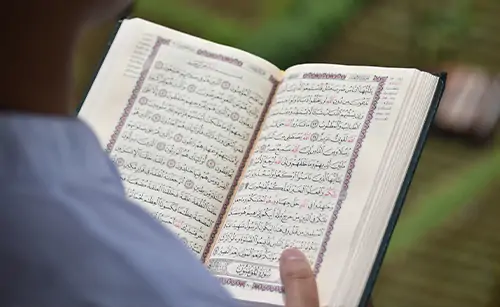What is Madd in Tajweed?

Imagine sitting with a Quran in front of you, reciting softly, when you come across a word that seems to stretch longer than the rest. That stretch is not random. It is part of the science of Tajweed, and it is called Madd.
In simple words, what is Madd? Madd (مَدّ) means “to stretch.” In Tajweed definition, it refers to the extension of a sound when certain madd letters appear in recitation. Understanding madd meaning helps Muslims beautify their recitation, pronounce words correctly, and avoid mistakes in reading the Quran.
Madd Definition and Meaning
The madd definition is to prolong the sound of one of the three maddah letters:
- Alif (ا) – when it comes after a fatha (zabar) ( ـَ )
- Waw (و) – when it comes after a damma (zeer) ( ـُ )
- Ya (ي) – when it comes after a kasra (peesh) ( ـِ )
These are also called madd letters, and they make the recitation flow beautifully, like a melody. In the mad in Arabic language, “madd” literally means to extend or stretch. Some even search for m.a.d.d meaning or m.a.d.d definition, but both point back to this same concept of stretching sounds.
Types of Madd in Tajweed
There isn’t just one type of madd. Just like learning music notes, each stretch has a unique rule. The types of madd are divided into two main groups:
- Madd Asli (Natural Madd)
- Also called madd asli rule, this is the basic stretching of two counts.
- Example: The word قَالَ (qaala) where the alif is stretched naturally.
- These are simple natural madd examples every beginner learns first.
- Also called madd asli rule, this is the basic stretching of two counts.
- Madd Far’ee (Secondary Madd)
These occur when additional conditions appear. Some important types include:
a. Madd Al-Muttasil (Connected Elongation)
- Example: سَمَآءٌ (samā'un - "sky")
- Explanation: The Madd letter Alif is followed by a Hamzah within the same word, requiring a mandatory extension of 4 or 5 counts.
b. Madd Al-Munfasil (Disconnected Elongation)
- Example: يَا أَيُّهَا (yā ayyuhā - "O mankind")
- Explanation: The Madd letter Alif is in one word, and the Hamzah is in the next word. This elongation is permissible and can be 4 or 5 counts.
c. Madd Al-Aarid Lil Sukoon (Temporary Elongation for a Stopping)
- Example: الْعَالَمِينَ (al-ʿālamīn - "the worlds")
- Explanation: When you stop at the end of the word "العالمين", the final letter is given a temporary Sukoon, and the Madd letter is prolonged for 2, 4, or 6 counts.
d. Madd Leen (Soft Elongation)
- Example: بَيْت (bayt - "house")
- Explanation: This involves the letters Waw or Yaa with a Sukoon after a Fatha, such as in 'بَيْت', where the Yaa is pronounced softly without strong elongation, or اَوْ (aw - "or") and اَيْ (ay - "or")
These are essential parts of tajweed rules Quran, helping Muslims recite correctly. A tajweed rules chart can make them much easier to visualize for learners.If you want to learn it properly, you can join the Awwal Quran with Tajweed Course, and soon we will discuss it in detail in our upcoming blog.

Tajweed Rules and Madd
Learning Madd is incomplete without grasping the rules of Tajweed. Tajweed is like the grammar of Quran recitation — it tells us where to stretch, pause, or shorten.
- All Tajweed rules are designed to preserve the original way Prophet Muhammad ﷺ recited the Quran.
- Rules like damma, fatha, kasra (the short vowels) combine with madd letters to create Arabic words with long vowels.
- For example: aa in Arabic letter is shown by alif madda.
- Sometimes, learners notice the longest Arabic character being stretched, and this comes under Madd.
The Beauty of Maddah Letters in Arabic
The mad in Arabic is not just a technical rule — it’s part of the language’s beauty. Arabic itself has sounds that need to be elongated for meaning. Without Madd, the meaning of some words can completely change.
- For example, in Arabic damma ( ُ ), if followed by waw, the sound becomes longer.
- Similarly, sakin letters (letters with sukoon) also interact with Madd in unique ways.
This is why scholars often say that Madd brings the soul of tajweed alive.
Modern Reflections on Madd
In today’s world, even social platforms highlight tajweed discussions. For instance, on Tabee 31 Twitter, learners often share insights, rules, and questions about Madd and Tajweed. It shows that the love for reciting Quran beautifully continues across generations and even digital spaces.
Why Understanding Madd Matters
Have you ever wondered how many letters are in the Quran? Each of those letters deserves to be recited correctly. Without Madd, one could mispronounce a word and change its meaning.
By understanding Madd, learners:
- Recite Quran with confidence.
- Preserve the beauty of Allah’s words.
- Pass on the correct method of reading to the next generation.
This is why courses like Learn Tajweed Online at platforms such as Awwal Quran make it easier for beginners and kids to understand Madd step by step.
Conclusion
So, when someone asks: “What is Madd in Tajweed?” — it is the art of stretching letters in Quran recitation according to the rules of Tajweed. Whether it’s madd asli rule, madd e muttasil, or madd lazim, each type carries its own rhythm and beauty.
When Muslims learn Madd, they don’t just pronounce words correctly — they follow the footsteps of the Prophet ﷺ and preserve the melody of the Quran exactly as Allah revealed it.
FAQs on Madd in Tajweed
What is maddah letters in Tajweed?
Madd in Tajweed means to stretch the sound of certain letters, called maddah letters, during Quran recitation.
What are the Madd letters?
The three maddah letters are: Alif (ا) after a fatha, Waw (و) after a damma, and Ya (ي) after a kasra.
What is Madd Asli?
Madd Asli rule is the natural Madd, stretched for two counts. It is also called natural Madd and is the foundation of all other types.
What is Madd Lazim?
Madd Lazim occurs when a Madd letter is followed by a sukoon or shaddah. It is a compulsory stretch, often seen in the Quran’s beginning letters, such as in madd lazim harfi mukhaffaf examples.
What is Madd Muttasil?
Madd e Muttasil (or Madd Muttasil) occurs when a hamzah (ء) follows a Madd letter in the same word, which makes the sound longer.
What is Madd Badal?
Madd Badal is when a hamzah (ء) comes before a Madd letter. The reciter stretches it for two counts.
Why is Madd important in Tajweed?
Madd preserves the correct pronunciation and beauty of Quran recitation. It ensures clarity, avoids changing meanings, and follows the tajweed rules Quran.
How do vowels affect Madd?
Short vowels (damma, fatha, kasra) become long when combined with Madd letters. For example, aa in Arabic letter is shown by Alif Madda.
How many letters are in the Quran?
Scholars note that the Quran contains more than 300,000 letters, and Muslims must recite each one correctly by following Tajweed rules.
Can kids learn Madd easily?
Yes! With a tajweed rules chart and guidance from a teacher, even children can quickly understand types of Madd and practice with natural Madd examples.














